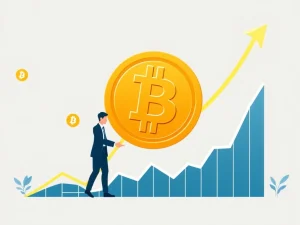XRP Scams: Urgent Warning from Ripple CTO on Rising Impersonation Threats

In the dynamic realm of cryptocurrency, vigilance is not just a recommendation—it’s a necessity. For XRP holders, the digital landscape, while brimming with innovation, also presents a fertile ground for sophisticated fraudsters. Today, we bring you an urgent alert directly from Ripple, underscoring a pervasive threat that demands immediate attention from every investor.
Ripple CTO Warning: A Direct Message to XRP Holders
The digital world is a double-edged sword, offering connectivity but also new avenues for deception. David Schwartz, Ripple’s Chief Technology Officer, recently issued a stark Ripple CTO warning that every XRP enthusiast should take to heart. In a clear public statement on X (formerly Twitter), Schwartz debunked claims of his presence on Instagram, stating unequivocally: “I do not post to Instagram. Any profile you see there that claims to be me is a scam.” This direct denial aims to dismantle confusion sown by fake profiles impersonating him. This incident is not isolated; it’s part of a worrying trend of impersonation attempts across various platforms, including YouTube, where scammers hijack accounts to spread misleading content under Ripple’s guise. The message from Ripple is clear: neither the company nor its executives will ever solicit XRP transfers or digital assets directly from users. This proactive communication aligns with Ripple’s continuous efforts to educate its community on verifying official channels and sources of information.
Unmasking Instagram Crypto Scams: What Should You Look For?
The proliferation of fake accounts and phishing schemes targeting investors is a significant challenge in the cryptocurrency sector. Specifically, Instagram crypto scams have become a popular vector for fraudsters due to the platform’s vast user base and visual nature. Scammers leverage cloned profiles that appear legitimate, often mimicking high-profile individuals like David Schwartz or Brad Garlinghouse. These schemes are increasingly sophisticated, sometimes incorporating AI-generated content and deepfake videos to promote fake investment opportunities. The ease with which these fake profiles can be created and the difficulty platforms face in promptly removing them contribute to the problem. For instance, reports indicate a surge in fraudulent activities involving compromised YouTube channels and deepfake videos. It’s a stark reminder that if an offer seems too good to be true, it almost certainly is.
Protecting XRP Holders: Actionable Insights for Digital Safety
For XRP holders, safeguarding your assets begins with proactive measures and a healthy dose of skepticism. Ripple has consistently advised its community to rely solely on its official website and verified social media accounts for updates and crucial information. This is particularly vital when interacting with executives. Here are key actionable insights to protect yourself:
- Verify Official Channels: Always cross-check information against Ripple’s publicly listed verified social media handles and official website.
- Beware of Unsolicited Requests: Remember, Ripple or its executives will never ask you to send XRP or any other digital asset. Any such request is a scam.
- Scrutinize Social Media Profiles: Look for discrepancies, follower counts that seem off, or unusual posting patterns. A verified badge doesn’t guarantee authenticity if the content is suspicious.
- Report Suspicious Activity: If you encounter a suspicious profile or scam attempt, report it to the platform immediately and consider notifying Ripple’s official support channels.
Enhancing Your Overall Crypto Security: Beyond Impersonation
While impersonation scams are a significant threat, building robust crypto security extends to all aspects of your digital interactions. The lessons learned from the recent warnings apply broadly across the crypto ecosystem. As cryptocurrencies gain mainstream adoption, the frequency and sophistication of scams are expected to rise.
Consider these broader security practices:
- Use Hardware Wallets: For significant holdings, hardware wallets offer superior security against online threats.
- Enable Two-Factor Authentication (2FA): Apply 2FA on all your crypto exchanges, wallets, and social media accounts.
- Be Wary of Phishing Links: Always double-check URLs before clicking, especially those received via email or direct messages.
- Educate Yourself Continuously: Stay informed about new scam tactics and security best practices.
- Avoid Public Wi-Fi for Transactions: Public networks are often less secure and susceptible to eavesdropping.
The Broader Landscape of XRP Scams: A Systemic Challenge
The recent incidents highlight a systemic vulnerability within social media platforms themselves. Despite growing awareness, impersonation remains a persistent issue, impacting not just XRP but the entire crypto market. This situation may prompt broader discussions among regulators and platforms regarding accountability. How do platforms balance free expression with user protection when sophisticated XRP scams leverage their services? Ripple’s proactive warnings set a precedent, potentially encouraging other crypto firms to adopt similar transparency measures, such as publicly listing verified accounts and issuing regular scam alerts. The industry’s collective effort is crucial in mitigating these risks as the digital asset space continues to evolve.
Conclusion
David Schwartz’s timely Ripple CTO warning serves as a critical reminder of the ongoing battle against digital fraud. For XRP holders, staying informed and exercising extreme caution is paramount. By understanding the tactics of Instagram crypto scams and adopting comprehensive crypto security measures, you can significantly reduce your vulnerability to XRP scams. Always remember: verify, don’t trust, and never share your private keys or send funds to unsolicited requests. Your digital assets depend on your vigilance.
Frequently Asked Questions (FAQs)
Q1: Why is Ripple’s CTO warning XRP holders about Instagram scams specifically?
A1: Ripple’s CTO, David Schwartz, issued a specific warning because scammers are actively creating fake profiles on platforms like Instagram, impersonating him and other Ripple executives to trick XRP holders into sending them funds or divulging sensitive information. These platforms are popular targets due to their large user bases.
Q2: How can I verify if a social media account claiming to be a Ripple executive is legitimate?
A2: Ripple advises relying solely on its official website and verified social media accounts for updates. David Schwartz explicitly stated he does not post to Instagram. Always cross-check information against Ripple’s publicly listed official handles and be wary of any unsolicited requests for funds.
Q3: What are some common tactics used in crypto impersonation scams?
A3: Common tactics include creating fake profiles mimicking legitimate figures, using AI-generated content and deepfake videos to promote fake investment opportunities, hijacking legitimate social media accounts, and sending direct messages asking for cryptocurrency transfers or personal information.
Q4: Besides Instagram, what other platforms are commonly used for crypto scams?
A4: Scammers frequently use platforms like X (formerly Twitter), YouTube, Telegram, and Discord. They exploit these platforms’ reach to disseminate misleading content, promote fake giveaways, and conduct phishing schemes.
Q5: What should I do if I encounter a suspected XRP scam or impersonation attempt?
A5: If you encounter a suspicious profile or scam attempt, report it immediately to the social media platform. Additionally, you can consider notifying Ripple’s official support channels to help them track and address fraudulent activities. Never engage with the scammer or send any funds.










